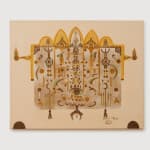Juliana SERAPHIM Palestinian-Lebanese, 1934-2005
The Golden Palace, 1980 c.
Oil, sand and gold leaf on canvas
80 x 100 cm
Pioneering Lebanese Surrealist artist Juliana SERAPHIM (1934 - 2005) was born in Palestine and moved to Beirut at the age of 14 with her family. She was one of the...
Pioneering Lebanese Surrealist artist Juliana SERAPHIM (1934 - 2005) was born in Palestine and moved to Beirut at the age of 14 with her family. She was one of the first generation of Palestinian artists whose practices evolved in exile. She studied under the painter Jean Khalife whilst simultaneously working for the United Nations Agency assisting refugees. In the late 1950s, she moved to Florence, Italy, studying at the Academy of Fine Arts, with later studies in Paris and Madrid.
Now considered one of the pioneers of the celebrated Beirut art scene which emerged in the 1960s, Seraphim’s unique form of Surrealism marks her out from her contemporaries. Considered an outsider by the more politically active artists, her artworks didn’t explicitly engage with the Palestinian national cause; instead, she developed a unique, sensually visual vocabulary rooted in the perception of a “woman’s world”. Her paintings are characterised by layers of erotic, dreamlike imagery and characters that morph into plants and flowers. Seraphim’s works embody spirituality, sexuality, mythology with her own childhood memories and upbringing; merging the beautiful with the grotesque and executed in a hyper-feminine style.
Seraphim was one of the first Lebanese women artists to survive entirely from her art; she represented Lebanon in international exhibitions, including the biennials of Alexandria, 1962, Paris, 1963, and São Paulo, 1965.
Recent important group exhibitions which have have cemented her position include 'Arab Presence, Modern Art and Decolonization: Paris 1908 – 1988', Musée d’Art Moderne, Paris, 2024 and 'Beirut and The Golden Sixties', Biennale de Lyon, 2022.
Now considered one of the pioneers of the celebrated Beirut art scene which emerged in the 1960s, Seraphim’s unique form of Surrealism marks her out from her contemporaries. Considered an outsider by the more politically active artists, her artworks didn’t explicitly engage with the Palestinian national cause; instead, she developed a unique, sensually visual vocabulary rooted in the perception of a “woman’s world”. Her paintings are characterised by layers of erotic, dreamlike imagery and characters that morph into plants and flowers. Seraphim’s works embody spirituality, sexuality, mythology with her own childhood memories and upbringing; merging the beautiful with the grotesque and executed in a hyper-feminine style.
Seraphim was one of the first Lebanese women artists to survive entirely from her art; she represented Lebanon in international exhibitions, including the biennials of Alexandria, 1962, Paris, 1963, and São Paulo, 1965.
Recent important group exhibitions which have have cemented her position include 'Arab Presence, Modern Art and Decolonization: Paris 1908 – 1988', Musée d’Art Moderne, Paris, 2024 and 'Beirut and The Golden Sixties', Biennale de Lyon, 2022.
Join our mailing list
* denotes required fields
We will process the personal data you have supplied to communicate with you in accordance with our Privacy Policy. You can unsubscribe or change your preferences at any time by clicking the link in our emails.



